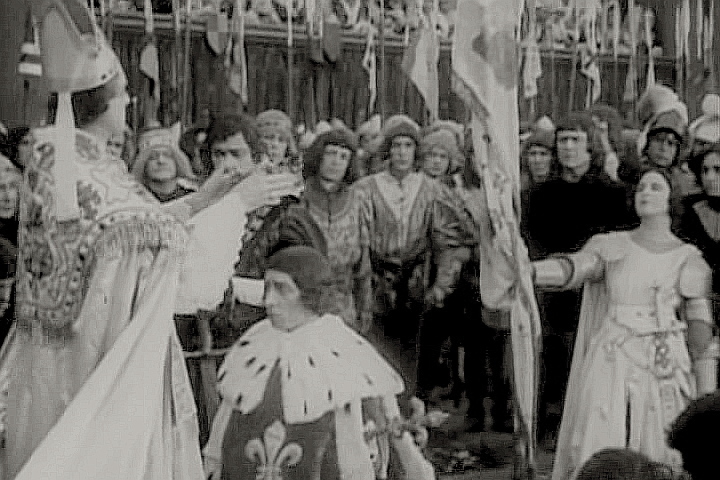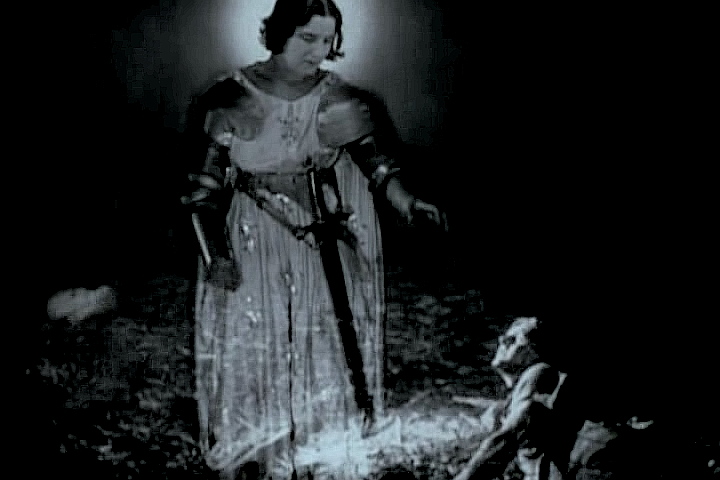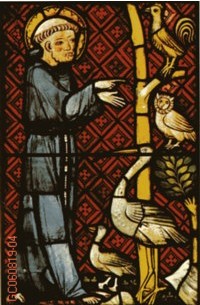Saint Joan of Arc
A Second Patron Saint of France
Joan of Arc had not been always an deniable favourite character in England. As a matter she was a chief opponent to England's dominance in France during the Hundred Years War. The English argued the young daughter of a peasant from a village Domrémy in northeastern France who could not halt the previously successful campaigns of the English armies in France by anything except by sorcery and deceits. After the death of Joan of Arc in 1431, the regions loyal to the new king Charles VII rallied together and began to reclaim territories from the English. In 1435, Philip the Good (the Duke of Burgundy), broke with the English, signed a treaty with Charles, and accepted Charles the rightful king of France. In 1436, Charles laid a siege on Paris with the aid of the Burgundian troops; Paris was captured. Although Philip broke with alliance with Charles in 1439, the Burgundian did not interfere with the struggle between Charles and England.
15th century drawing in a book by Charles of Orleans
In November 1449 Rouen was in the hands of Charles; after a few months, he initialed the investigation of Joan's trial in February 1450. The retreating English still possessed a few coastal cities and the western regions in Bordeaux and Normandy. Charles was not in hurry to clear Joan's name and the Catholic Church in Rome was preoccupied by the Ottoman Empire. By 1455, Charles won the long war against England and successfully drove the English out of France, who held only the city of Calais. In November 1455, the new pope Callixtus III ordered a retrial upon receiving the petition by Joan's elderly mother Isabelle Romeé. The rehabilitation trial annulled the witch verdict and declared her innocence in 1456, although English held the opinion that Joan was a crafty witch for centuries.
For example,
William Shakespeare included Joan of Arc in his historical play of Henry the Sixth, Part One, as a person practiced witchcraft and had the helps of fiends.

 In Act IV - Scene III
In Act IV - Scene IIIJoan (The Maid or La Pucelle) entices the Duke of Burgundy to leave English and follow Charles. Burgundy: "Either she hath bewitch'd me with her words. Or nature makes me suddenly relent."
In Act V, Scene III
Pucelle: "The regent conquers, and the Frenchman fly.-- Now help, ye charming spells, and periapts; and ye choice spirits that admonish me, and give me signs of future accidents -- [Thunder.] You speedy helpers, that are substitutes under the lordly monarch of the north. Appear, and aid me in this enterprise! ..."

In Act V - Scene IV
In the camp of the Duke of York, Joan rejects a shepherd who claims to be her father. York: "Take her away; for she hath liv'd too long. To fill the world with vicious qualities."
In the subsequent centuries, English still basically held the same opinion on Joan, while France emerged as a new power in the European continent and fought with England until the defeat of Napoleon Bonaparte in the 18th century. After the demise of first Bonaparte empire, France saw through the return of the Bourbon monarchy, the second republic, and the second empire. The two rivals, England and France, were finally at peace; Napoleon III and England even fought Russia together in the Crimean War (1854-56).
Illustrations by Sir John Gilbert (1817-97)
Meanwhile through centuries, Joan became a national symbol for unity and patriotism in France, except in the turbulent times of French Wars of Religion and French revolution. In the 18th century, some English authors made efforts to re-interpret Joan's role centuries ago. During the WWI, Joan was reported to appear before the allied soldiers in the battlefield. Later, Joan was beatified by Pope Pius X in April 1909 and canonized by Pope Benedict XV in May 1920. Saint Joan is one of France's second patron saints and her feast day is May 30.
After WWI, Joan attracted interest in the English-speaking world. George Bernard Shaw wrote a play "Saint Joan" which was premiered in December 1923, and there are numerous movies about Joan.
Snapshots from the Movie Joan the Woman
The American movie was played by Geraldine Farra and was released in December 1916. |
 |
| a WWI trench in France | Joan and the blessing of her standard |
|---|---|
 |
 |
| Joan with companions entering Orleans | Joan of Arc standing behind Charles in Reims |
 |
 |
| Coronation of Charles VII | WWI battlefield in France |

"Joan was a being so uplifted from the ordinary run of mankind
that she finds no equal in a thousand years."
- Winston Churchill
Click to see Joan the Maid/Jeanne la Pucelle
Joan's statue, Place des Pyramides, Paris
Top | Bottom of PageSaint Francis of Assissi
The Saint of Ecology and All Creatures
Born into a wealthy family in the town of Assisi in Italy, Saint Francis (1182-1226) was brought up in
luxury and had the company of young princes and noblemen.
One day a beggar came pleading for alms, the soft-hearted Francis gave him all in his pockets. He
started to think about the low wretches and he gave his money to the poor since then. Later he
was to die of a serious disease but he recovered miraculously. He had a vision of Jesus and
made a determination to dedicate his life to the service of humanity. His father disapproved of
this and turned him out of the house; therefore Francis found shelter in a cave in the mountains
and lived like a beggar.
Preaching the love of God from village to village, Francis invited people to join him in his life of service.
One rich man of Assisi was very much attracted by the saintliness of Francis and joined
Francis. Bernard was his first follower and eleven others also joined Francis.
Francis and his followers went all over Italy, preaching, teaching, healing and blessing.
His gospel of kindness and love soon spread all over Europe. People called him the little
poor man of Assisi and started to call him a saint.
Francis was humble and loved all creation of God. He delighted to commune with the wild flowers,
the spring, and the fire, and to greet the sun. He treated the birds, the beasts and all creatures
as brothers and sisters.
One day, Francis and his companions travelled by a road where birds filled the trees
on either side. Francis told his companions to "Wait for me while I go to preach to
my sisters, the birds." The birds surrounded him, drawn by the power of his voice, and not one of them flew away.
Francis spoke to them:
"My sister birds, you owe much to God, and you must always and in everyplace give praise to Him; for He has given you freedom to wing through the sky and He has clothed you. You neither sow nor reap, and God feeds you and gives you rivers and fountains for your thirst, and mountains and valleys for shelter, and tall trees for your nests. And although you neither know how to spin or weave, God dresses you and your children, for the Creator loves you greatly and He blesses you abundantly. Therefore, always seek to praise God."Another legend was about a wolf that terrified the townsfolk of the city of Gubbio and devoured men as well as animals. Francis went up into the hills to find the wolf. All his companions fled, but he pressed on and found the wolf. Making the sign of the cross, he commanded the wolf to come to him and hurt no one. The wolf closed his jaws and lay down at the feet of St. Francis. Then he led the wolf into the town. The startled citizens witnessed that he made a pact between them and the wolf. The wolf had done evil out of hunger and would not bother the townsfolk and their flocks. In return, they were to feed the wolf regularly. Francis even made a pact on behalf of the town dogs with the wolf.
Top | Bottom of Page
Prayers of Saint Francis of Assissi
|
O Lord, make me an instrument of Thy Peace! Where there is hatred, let me sow love; where there is injury, pardon; where there is doubt, faith; where there is despair, hope; where there is darkness, light; and where there is sorrow, joy. O Divine Master, grant that I may not so much seek to be consoled as to console; to be understood as to understand; to be loved as to love. For it is in giving that we receive; It is in pardoning that we are pardoned; and it is in dying that we are born to eternal Life. St. Francis of Assisi |
Dieu, faites de moi un unstrument de votre paix! Là où nous trouvons la haine, permettez-moi de semer l'amour; là où nous trouvons des injures, le pardon; là où nous trouvons l'incertitude, la foi; là où nous trouvons le désepoir, l'espoir; là où nous trouvons l'obscurité, la lumière; et là où nous trovons la tristesse, la joie. O Maître Divin, de grâce acccordez-moi de ne pas tant poursuivre d'être consolé que de consoler; d'être compris que de comprendre; d'être amé que d'aimer. Car c'est en donnant que nous recevons, en pardonnant que nous sommes pardonné et en mourant que nous naissons à la vie éternelle. St. François d'Assise |
The following helps to keep faith (texts in English and Italian)
| A Prayer before a Crucifix | Preghiers davanti al Crocifisso |
Most High, glorious God, enlighten the shadows of my heart, and grant unto me a right faith, a certain hope and perfect charity, sense and understanding, Lord, so that I may accomplish The holy and true command. St. Francis of Assisi |
Altissimo glorisos Dio, illumina le tendebre de lo core mio. Et dame fede dicta, speranza certa e carità perfecta, senno e cognoscemento, Signore, che faccia lo tuo santo e verace comandanento. San Franceso di Assisi |
|---|